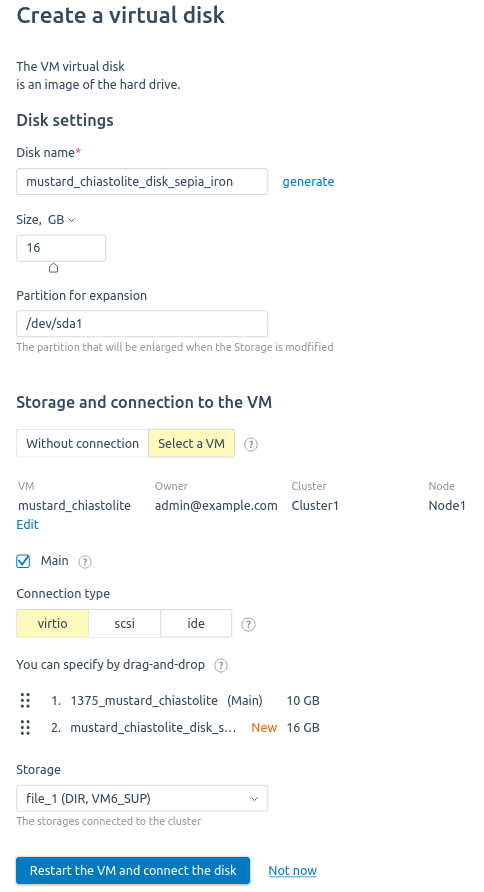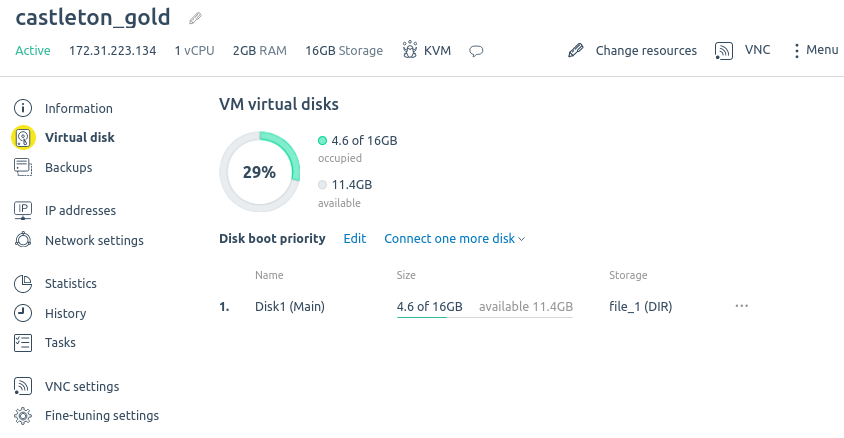Managing VM disks
You can connect additional disks to the virtual machine (VM). The platform allows you to connect a virtual disk with a controller:
- VirtIO — connecting requires a driver to be installed in the operating system (OS);
- SCSI — supported by all modern operating systems. A maximum of fourteen disks of this type can be connected to one VM;
- IDE — supported by all operating systems. A maximum of three disks of this type can be connected to one VM.
One of the disks in the VM is the main disk. This disk is available for management from the billing system and cannot be disconnected from the VM.
Creating a virtual disk
Enter Virtual machines → VM disks → Create a virtual disk.
Specify the disk parameters:
Disk name.
Size, Gb.
Partition for expansion — the partition that will be enlarged when the Storage parameter is modified.
Select a primary or extended partition to enlarge. Enlarging logical partitions is not supported.
To create a disk:
without mounting it to the VM:
- Press Without connection.
- Select the disk Owner.
- Select the Storage. You will be able to connect the disk to VMs having access to this storage.
- Select the cluster Node.
- Press Create without connection.
with mounting it to the VM:
Press Select a VM.
- Select the VM to connect the disk to.
- If necessary, enable the option Main. The main disk can be managed from the billing system and cannot be disconnected from the VM.
- Select the Connecting type:
- VirtIO;
- SCSI;
IDE.
If you select IDE, the virtual machine will reboot.
Set the boot priority of the disks by arranging the names of the disks in the required order.
If you change the priority, the virtual machine will reboot.
- Select the Storage.
- Press Connect the disk (Restart the VM and connect the disk).
- To enable the VM to work with the disk, create a boot record and partitions on the disk using the OS tools.

Creating a disk with connecting to the VM
Managing virtual disks
VM Disks section
To manage disks, enter Virtual machines → VM disks. The following operations are available for disks through the ![]() menu:
menu:
- Edit disk — allows you to change the disk settings. The VM will reboot if the disk size or connecting type is changed;
- Migrate to the other storage — the virtual disk will be moved to a new storage;
- Connect/Disconnect the disk from the VM — any disk can be disconnected, except the primary one. The VM will reboot for this operation;
- Create a backup copy of the disk;
- Delete disk — only for disks, which are not connected to a VM.
VM card
To manage the disks of a particular VM, open its card and go to the Virtual disk tab.
To change the boot priority of the disks, press Edit and arrange the disk names in the required order. The VM will reboot to perform the operation.
To connect a disk to a VM, press Connect one more disks. You can connect one of the disks you have created or create a new one. If you connect an IDE disk, the VM will reboot.
The following operations are available for disks through the ![]() menu:
menu:
- Edit disk — allows you to change the disk settings. The VM will reboot if the disk size or connecting type is changed;
- Migrate to the other storage — the virtual disk will be moved to a new storage;
- Disconnect the disk from the VM — any disk can be disconnected, except the primary one. The VM will reboot for this operation;
- Set as Main;
- Create a backup copy of the disk.

Tab interface
User possibilities for disk management
To allow users to manage virtual disks, enable the Users can connect/disconnect their VM disks option in the cluster settings.
Functions available to users:
| User level | Available functions |
|---|---|
| User |
|
Advanced user |
|